November 17, 2006
Air Date: November 17, 2006
FULL SHOW
SEGMENTS
Drilling Beneath the Seas
/ Jeff YoungView the page for this story
The Republican-controlled Congress has a few more weeks before they hand over control to Democrats. One item high on the agenda is a proposal to expand offshore oil drilling. Living on Earth's Jeff Young reports from Capitol Hill. (05:30)
Boxer Sets Agenda on Environment
View the page for this story
After years of criticizing Republican environmental policy California Barbara Boxer is set to take control of the Senate's Environment and Public Works Committee. Senator Boxer tells host Bruce Gellerman about her plans to tackle climate change, toxic chemical cleanup and more. (06:30)
Nairobi Climate Talks
/ Terry FitzPatrickView the page for this story
At the latest world meeting on confronting climate change, environment ministers prioritized helping poor countries who are on the frontlines of global warming. But producer Terry FitzPatrick reports there was not much progress on the key issue of limiting emissions from the powerhouse countries of China, India and Brazil. (08:00)
Trash Vortex
View the page for this story
Researchers have discovered a Texas-sized area of trash floating in the Pacific Ocean. Composed primarily of plastic garbage from landlubbers, the area has become both a major threat to marine life and a frightening example of how polluted our oceans are. Living on Earth speaks with Adam Walters, a scientist for Greenpeace who is monitoring the vortex aboard the vessel Esperanza. (05:15)
LOE Mailbag
View the page for this story
We dip into the Living on Earth mailbag to hear from our listeners. (03:00)
Emerging Science Note/Nanorust
/ Ian GrayView the page for this story
Scientists say rust, magnets and olive oil may be the solution to cleaning water with arsenic in developing nations. Ian Gray reports. (01:30)
Mad Sheep
View the page for this story
In 2001, the USDA seized and slaughtered a flock of sheep that belonged to a Vermont farming family. The government thought the sheep might be infected with a strain of Mad Cow Disease, but the Faillace family accused the USDA of shoddy science. Linda Faillace wrote a book about her family's experience and shares her story with Living on Earth’s Steve Curwood. (08:30)
High Art
View the page for this story
Conceptual artist Mary Ellen Carroll discusses her new project "Indestructible Language," a 900-foot long installation built to call attention to climate change. (04:15)
Cranberries Take Centerstage
View the page for this story
An audio postcard of an old Thanksgiving standby: the cranberry. (04:00)
Show Credits and Funders
Show Transcript
HOST: Bruce Gellerman
GUEST: Senator Barbara Boxer, Adam Walters, Linda Faillace, Heather Faillace, Mary Ellen Carroll
REPORTER: Jeff Young, Terry FitzPatrick
SCIENCE NOTE: Ian Gray
[THEME]
GELLERMAN: From Public Radio International - this is Living on Earth.
[THEME]
GELLERMAN: I’m Bruce Gellerman.
With the clock ticking on their majority rule, Congressional Republicans want to lift the twenty-five year moratorium on offshore drilling.
DOMENICI: It has been sitting there under moratoria, meaning moribund, dead, because we were frightened of ourselves.
GELLERMAN: Republicans may be lame ducks but they’re still hoping their proposal for offshore drilling will fly. And surprisingly, some environmental groups say going along could pay.
Also, Democrat Barbara Boxer gears up to take charge of the Senate’s Environment and Public Works Committee.
BOXER: I mean my goodness, when this country is rated 53 out of 56 in efforts to clean up carbon, you know we’ve lost our way. So my role as I see it as chair of this really historic and important committee is to get us back on the right path.
GELLERMAN: Barbara Boxer pulls no punches. That and more this week on Living on Earth. Stick around!
[NPR NEWS CAST]
ANNOUNCER: Support for Living on Earth comes from the National Science Foundation and Stonyfield Farm.
Drilling Beneath the Seas
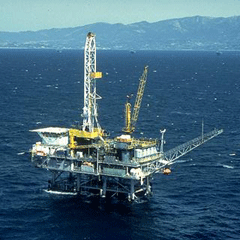
Offshore drilling supplies about 25 percent of the nation’s natural gas production. (Courtesy of Department of the Interior)
GELLERMAN: From the Jennifer and Ted Stanley Studios in Somerville, Massachusetts - this is Living on Earth. I’m Bruce Gellerman. Time’s running out for Congressional Republicans. But before they give up the reins of power in Congress, the lame duck lawmakers want to pass a controversial piece of legislation. It would open up offshore drilling to oil and gas companies. And as Living on Earth’s Jeff Young tells us, support for the proposal is coming from an unsual source—some environmental groups.
YOUNG: For 25 years most of the outer continental shelf has been off limits for offshore drilling. Federal moratoria ban new oil and gas exploration from nearly all US coasts, except in the western Gulf of Mexico. New Mexico Republican Pete Domenici, who heads the Senate’s energy committee, says it’s time for that to end.
DOMENICI: And the American people should know that the outer continental shelf, which belongs to them, contains invaluable resources for their future to go and drill for.
YOUNG: Both the House and senate passed bills to expand offshore drilling. The expansive House bill would have ended all federal moratoria on drilling in favor of letting states decide. That measure appears to be dead. But Domenici and other drilling supporters hope something close to the Senate’s version might still pass in the final weeks of the 109th Congress. That bill would give oil and gas companies access to about 8 million acres deep in the central Gulf of Mexico.

Offshore drilling supplies about 25 percent of the nation’s natural gas production.(Courtesy of Department of the Interior)
YOUNG: Domenici says the area is rich in natural gas and could yield more than a billion barrels of oil. His supporters say drilling technology has come a long way since oil spills in the late 60’s turned the tide of public opinion against offshore drilling. But environmentalists argue that even though oil platforms are safer, pipelines and tankers are still risky. Mike Gravitz of the US Public Interest Research Group says ending the moratorium in this spot could lead to more drills, and the risk of more spills, elsewhere.
GRAVITZ: I think that would set a bad precedent. And after all the solution to our energy problems, whether you want to call it energy security or independence, really does not lie at the end of a drill bit. It really lies in our own behavior and the kind of investments we make in this country over the next 20 years.

Forty-three wells exist off of the coast of California alone. (Courtesy of Department of Energy)
DAVIS: Coastal Louisiana is essentially disintegrating in large part because of the way it’s been managed over the past several generations unless we actually re-plumb the Mississippi River and the coastal landscape it will continue to disappear.
YOUNG: That will take money—lots of it. And offshore drilling bills would pump lots of money into Louisiana. Drilling supporters included something called revenue sharing. About a third of the money raised by lease sales and royalties would not go to the federal treasury but instead to the states that have drilling off their coasts. Louisiana has pledged to use that money to patch up its battered coast. Davis notes the irony here. It was the oil and gas industry that caused much of the damage with canals and pipelines that cut up the marsh. Now he hopes drilling revenue could help fix things.
DAVIS: If these dollars are gonna be generated, shouldn’t some of them go to dealing with the environmental costs that were incurred to create those dollars and produce that energy.
YOUNG: The idea of diverting federal dollars to the states is controversial on Capitol Hill. Some worry that other states will demand a piece of the pie, draining one of the biggest sources of federal revenue. But revenue sharing took on a new sense of urgency in the wake of hurricane Katrina.
[SOUND UNDER WOMEN’S VOICES, MILLING ABOUT]
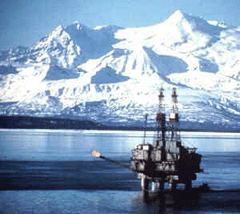
Offshore drilling rigs can stand and operate in water that is up to two miles deep.(Courtesy of Department of the Interior)
MILLING: We urge you to protect and restore America’s wetlands through the creation of a continuous funding stream now, before it’s too late. Thank you.
[APPLAUSE]
YOUNG: It’s a ticklish spot for national environmental groups. Mike Gravitz of the
Public Interest Research Group wants to help the Gulf coast rebuild but he does not want more oil rigs in gulf waters.
GRAVITZ: I can really understand why environmental groups in the gulf are really hungry for this kind of revenue to begin doing additional work on wetlands restoration. And all I would say is there are lots of other sources, alternative sources of financing, for that restoration.
YOUNG: Gravitz hopes that argument holds through mid-December, when the Republican-controlled lame duck Congress will end. Once Democrats take control, the chances for more offshore drilling will probably dry up.
For Living on Earth, I’m Jeff Young in Washington.
Related links:
- Naturalgas.org on Offshore Drilling
- The group America's Wetland supports a drilling bill with revenue sharing to
- US Public Interest Research Group opposes offshore drilling
Boxer Sets Agenda on Environment
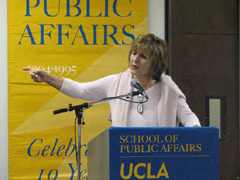
Senator Barbara Boxer at a recent event at UCLA.
GELLERMAN: It wouldn’t be an overstatement to say that the future of federal environmental policy lies in the hands of Barbara Boxer. The Democratic senator from California is slated to become the chair of the Senate Environment and Public Works Committee. In that powerful position, Senator Boxer will control the committee’s agenda. It’s also not an overstatement to say that Barbara Boxer is a fighter.
BOXER: (tape) Since his first day in office, President Bush has worked to roll back more than 350 laws and regulations that protect our public health and the environment. Any one of these rollbacks should be cause for a hearing in the Congress, should be a cause for consternation among the people. And I have to tell you, this has got to stop.
GELLERMAN: Senator Barbara Boxer joins us now from her Capitol Hill office. Senator, hello and welcome to Living on Earth.
BOXER: It’s lovely to be with you.
GELLERMAN: I was wondering, in your new role as head of the environment committee what’s at the very top of your agenda?

Boxer at UCLA Senator Barbara Boxer at a recent event at UCLA.
And the other issue that is also going to be my focus is protecting the health of our families, particularly our children. There are new reports out that show that, world wide, one in six children they’re experiencing neurological damage because of exposure to industrial waste and pollution. So these are the things we’re going to be working on, among many.
GELLERMAN: Senator, there were charges that the White House had politically influenced scientific findings.
BOXER: Mmm Hmmm.
GELLERMAN: In some cases, censored climate change studies. Are you going to hold hearings into those?
BOXER: Well, right now what I want to do is be positive and move forward. If the White House comes around and says they’re now convinced we need to move, that’s one set of circumstances. If they continue to cite these phony studies they may have politically influenced sure we’ll look into it. I mean what I want to do is get things done for the people. And to the extent that oversight helps me get things done for the people, we will use it. But clearly if we can do this in a bipartisan way, the people will be well served. Because the longer we wait on this challenge the more expensive it gets and the more dangerous it becomes.
GELLERMAN: Well how sanguine are you about bipartisanship? I mean you’ve got a fairly divided Senate, and well, you know you’ve got to have 60 votes in the Senate to get anything passed.
BOXER: There are some ways to get it done. But you’re absolutely right. Where it’s much easier in the House because of the way their rules are. In the Senate, unless you have 60 votes, it’s generally true. It’s hard to get things done. Having said that, my view has always been that when the American people want something done, and they are, their voices are heard, you have a good chance. And that’s why the first thing I’m doing is not putting legislation out there but the first thing I’m doing is holding a series of hearings starting in January to just shine the spotlight on global warming, children’s health and these other issues. So we have a lot of work ahead of us. And let me just say in my opinion, although I get along very very well with the former Chairman, we just don’t see things the same way. And I think there’s just a pent up demand for pro-environmental legislation.
GELLERMAN: Well that would be Senator Inhofe and he says climate change is essentially a sham.
BOXER: Yeah and they lost the election. So, you know, he’s not the chairman so he’ll be one vote. And I’m sure he’ll be vociferous and that will even crystallize the debate even more. He may be the last human standing who says it’s a hoax, you know.
GELLERMAN: Senator Boxer, you highlighted problems with the Superfund and toxic waste clean up program. What’s wrong with it? How can it be improved?
BOXER: Well, first of all we’ve lost our funding source. This is the first administration that has turned away from the fee on polluters. We believe polluters should pay. So we have a very big disagreement on that. What has happened then is you have to go to the general fund to clean up these sites, instead of having polluters pay and a lot of these sites have been neglected. And the EPA’s own admission is that there are a number of these sites that are out of control, meaning that people are being exposed to dangerous pollutants. They’re keeping these reports secret. They’re very secretive about this.
We’re using every tool at our disposal to get the information out to the public. The public right to know is very important to me. I’m such a believer in the people being given the facts and the truth, and then let them make the judgements. But if they don’t know and they don’t understand what these pollutants are, and how long it will take them to clean them up and all the rest of it, we’re really in big trouble. So this whole program needs to have the light on it, and we’re going to do that in the next Congress in January.
GELLERMAN: For the past six years you’ve been essentially out of power. What was it like sitting there through hearings and sessions?
BOXER: What it’s like to be in the minority, um, you have to learn patience. You have to learn that your first priority is stopping bad things from happening instead of moving forward with an agenda. You have to reach across party lines both when you’re in the majority and the minority here. It’s difficult. It’s a lot of reaching out. That’s fine. But I will tell you, for someone like me who believes government has a role in protecting the health and safety of the people it’s been very frustrating.
And I am so pleased to have this opportunity to move an agenda forward that I think will speak to the American people in a ways they haven’t been spoken to in a long time. That in fact the United States Senate cares about them, cares about the health of their kids, wants them to be able to stay healthy, breathe the air, drink the water, the whole thing, clean up the beaches, all the things we need to do to get America back on track.
I mean my goodness when this country is rated 53 out of 56 in efforts to clean up carbon you know we’ve lost our way so my role as I see it as chair of this really historic and important committee is to get us back on the right path. And I wanted to thank you so much for the opportunity to lay that out.
GELLERMAN: Well thank you, Senator. Senator Barbara Boxer is the next chair of the Environment and Public Works Committee.
Related links:
- Official website of Senator Barbara Boxer
- Senate Committee on Environment and Public Works.
[MUSIC: Harold Budd “Widow’s Charm” from ‘The Serpent (In Quicksilver) / Abandoned Cities’ (All Saints Records – 1991)]
GELLERMAN: Coming up: talking the talk on climate change in Nairobi, Kenya.
Just ahead on Living on Earth.
[MUSIC: Mory Kante “Diananko” from ‘Sabou’ (Riverboat U.K. Music - 2004)]
Nairobi Climate Talks
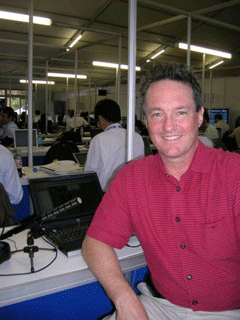
Reporter Terry FitzPatrick on site at the Nairobi conference.
BRUCE: It's Living On Earth, I'm Bruce Gellerman
[SWAHILI SINGING]
BRUCE: More than two thousand delegates from 189 countries have just wrapped up this year’s climate change conference in Nairobi, Kenya. U- N secretary general Kofi Annan told the delegates their job wasn’t just about protecting the environment. It was about fairness.
ANNAN: All of us want to see a day when everyone, not just a fortunate few, can live in dignity and look to the future with hope. That vision, which has always faced long odds, is being placed in deeper jeopardy by climate change.
BRUCE: There was a lot of talking, some progress, but little action coming out of the Nairobi conference -- at least on the key issue of limiting emissions of greenhouse gases.
Living on Earth’s Terry FitzPatrick joins us from Nairobi. Hi Terry.
TERRY: Jambo, Bruce.
BRUCE: Jambo, Terry. I understand the Kenyans took this gathering very seriously because for them the changing climate is not a distant concept.

Reporter Terry FitzPatrick on site at the Nairobi conference.
[SOUND OF MASAI VILLAGE]
TERRY: I went out one morning, Bruce, to the edge of Nairobi, to an area that’s called Kasarani. And there you can see collections of Masai herders squatting on vacant fields.
[COW SOUNDS FROM MASAI VILLAGE]
TERRY: The Masai, they’ve have always been nomadic, but the elder here, Ole Kisompol, says these families had to abandon their traditional lands because of relentless droughts.
KISOMPOL: (translated) He is saying the temperatures of here are getting more
hotter. When you look after cows or sheep, you feel like you want to melt because there is too much hot and the livestock are very much suffering because of that condition. Because when it rains, the grass just come--to be dry very, very soon. And then another drought come, another drought come, so that is how it affects them.
[MASAI PRAYER SINGING]
TERRY: Some of the displaced Masai herders actually came to downtown Nairobi to join a protest march for action on climate change. A couple thousand people sang these traditional songs as they held signs that said “stop climate chaos.”
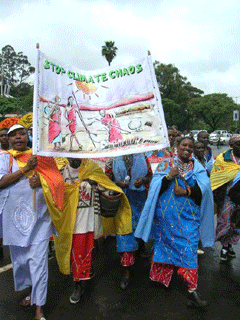
Protests abounded in downtown Nairobi. (Photo: Terry FitzPatrick)
BRUCE: Well Terry, is the Kyoto process prepared in any way to address their concerns and concerns like this?
TERRY: It is now. The Nairobi conference put in motion a fund to help poor countries adapt to climate change. In fact there’s a new buzzword and concept popping up now: making international aid “climate proof.” That’s the new word: climate proof. The fear is that development assistance to places like Kenya will be undermined by climate shifts and shocks.
BRUCE: Climate proof. How do you “climate proof” a country?
TERRY: Well, in some places you probably can't like parts of Bangladesh. But in some places, tidal barriers may lessen storm surges. Drought-resistant crops and livestock may help in other places. The Kyoto system creates a tax on some of the trading in pollution credits, which generates money that’s intended to help the poor countries. There’s only about 3 million in this fund right now – it’s just gotten started – but it is expected to grow rapidly.
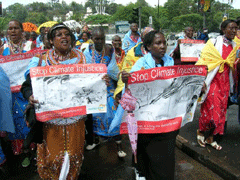
African farmers protest in downtown Nairobi.(Photo: Terry FitzPatrick)
TERRY: Well, no clear signs right now. These countries have been classified as "developing" in the Kyoto system, but they are of course developing rapidly. Many people feel they belong with the top tier of 35 nations that have signed formal commitments under Kyoto to reduce their emissions.
BRUCE: Are any of these developing-nation leaders talking about having a moral responsibility to address climate change by limiting their emissions?
TERRY: The Chinese and others are still saying that the top tier of nations should make the first move for what comes next after 2012 when the current Kyoto commitments come to an end. Even though China is on track to become the world’s largest emitter of carbon dioxide…and even though scientists are warning we’re near a tipping point now, possibly, where human action won't be able to head off severe climate disruption. The dynamic at these conferences is still something of a standoff. There is still a lot of "you first" "no, you first." That’s the attitude.
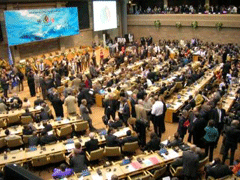
Thousands of delegates converge on Nairobi to chart a path forward on climate change. (Photo: Terry FitzPatrick)
TERRY: No, and the US continues to send lower level delegates to these conferences. Other countries send ministers. At this conference people were really saying that individual states may be where things move forward for now in the U.S., like the new program in California. In fact, some people were wearing buttons here; one has a picture of Governor Schwarzeneger saying “action hero,” and the other has an image of President Bush saying “action zero.”
BRUCE: Get me a couple of those buttons, Terry?
TERRY: You got it.
BRUCE: So, no comprehensive package for global emissions reductions in the post-2012 period coming out of this Nairobi conference then?
TERRY: No. More talking, but no commitments. And the fear is that there will be some kind of commitment gap coming after 2012 if no deal is done in time. What people worry about there is that a gap could undercut the growth in emissions trading system that is supposed to get the marketplace to solve the greenhouse gas problem.
BRUCE: So bottom line Terry, did anything come out of Nairobi?
TERRY: Well, trees.
MAATHAI: Now you will go down with it. Where is the shovel? Mr. president, now you shovel the soil.
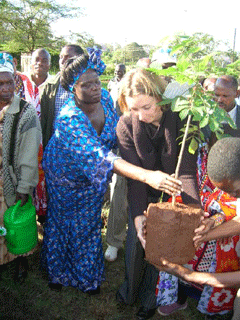
The U.N. launched the “Plant for the Planet: Billion Tree Campaign” at the conference in Nairobi. (Photo: Terry FitzPatrick)
MAATHAI: Okay, very well, now we’ll plant the next one.
TERRY: Trees absorb significant amounts of carbon from the atmosphere, and part of this billion-tree project is being financed by that pollution credit scheme. Maathai told people that trees will help Kenya cope with droughts and floods. But she says much more help is needed.
MAATHAI: If we do not include the forests, and yet this is one of the things that we at the grassroot can do, at least we have the muscle and we are willing to dig holes and plant trees and take care of them, then how will you help us? When we are drowning? This is the time to help!
[SINGING]
TERRY: So Bruce: six trees planted, and a new focus on helping developing countries like Kenya, but by the time these trees are six years old, no one is quite sure what kind of climate protection system is going to be in place.
BRUCE: Well thanks, Terry.
TERRY: My pleasure, Bruce.
BRUCE: Living on Earth’s Correspondent Terry FitzPatrick, in Nairobi.
[WOMEN SINGING]
Related links:
- United Nations Climate Change Conference
- The Climate Action Network - International
Trash Vortex
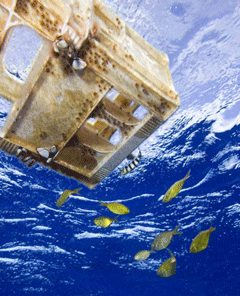
Fish swim amongst an abandoned plastic crate.(Photo: © Greenpeace/Alex Hofford)
GELLERMAN: Scientists have discovered a Texas-sized piece of the Pacific Ocean that’s sort of a magnet for garbage. They call it the “trash vortex.” In the calm waters halfway between Hawaii and the coast of California, they’ve found hundreds of millions of tons of flotsam--much of it is plastic. Adam Walters is a consulting scientist with Greenpeace International Research Lab, which is investigating the “trash vortex.”
He joins us by ship-to shore phone from the Greenpeace vessel Esperanza. Adam, where are you right now?
WALTERS: Currently we’re heading towards San Diego. We’re about 500 miles off the Californian coast.
GELLERMAN: So, were you in the trash vortex recently?
WALTERS: We’ve been close to the area where the plastic accumulates, yes.
GELLERMAN: What is it? It sounds something like a Bermuda Triangle in reverse. Instead of getting lost forever, whatever is in this vortex stays around forever.
WALTERS: Yeah, I mean that’s a pretty fair analogy. Basically what happens is that for most of the summer in this one area of the North Pacific about halfway between Hawaii and the US mainland, a high-pressure cell sits. This creates a very calm area of ocean surface. And as the currents circle around the whole of the North Pacific in a clock-wise direction plastic passes by this area and enters the calm and essentially just stays there.

Fish swim amongst an abandoned plastic crate. (Photo: © Greenpeace/Alex Hofford)
WALTERS: We’re finding incredible amounts of plastic. When we use our sampling device which collects pieces down to a third of a millimeter in size we see a massive increase in the amount of plastic that we’re collecting as we approach this area of accumulation.
GELLERMAN: Where is all this plastic coming from? Cruise ships, fishing ships?
WALTERS: UNEP the United Nations Environment Program, estimate that 80 percent of the plastics found in the ocean actually originate from land. Now it’s not a point source problem. This is coming from everywhere around the North Pacific. Potentially if you have a landfill site near the coast its going to be blowing off there. You see these huge clouds of plastic in some places, literally just blowing out to sea.
Another major source is storm drains. You have people littering on the streets then you get a massive downpour of rain. The storm drains come into action and wash all that plastic straight out to sea.
GELLERMAN: So what kind of stuff is it? What are you finding?
WALTERS: We’re finding an incredibly diverse range of plastic articles out here. Everything from lost fishing gear such as nets and floats through to a workman’s hard hat which had a fish living in it. Right down to marker pens and toothbrushes. Just about anything made of plastic has a chance of being out here.
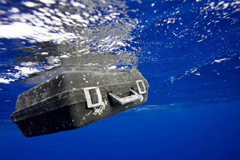
The contents of this suitcase are probably best kept contained. (Photo: © Greenpeace/Alex Hofford)
WALTERS: This is based on the research of Charles Moore of the Algalita Marine Research Foundation. And yes, he found that by dry weight the plastic outweighed the plankton six to one. If you consider that the plankton is acting as food for a lot of organisms out here in that area of ocean for every kilogram of plankton of food that they’re consuming they would consume six kilograms of plastic if they were not selective in their feeding.
GELLERMAN: Is the plastic toxic to sea life, and maybe more to the point, if I eat a fish that’s eaten plastic, is it toxic to me?
WALTERS: Now this is an interesting question and one that we currently don’t know the answer to. We’ve known about plastic being out in the ocean for decades. However, the range of effects it’s causing on marine life out here is only now becoming clear.
GELLERMAN: Are you finding trash vortexes in other oceans then?
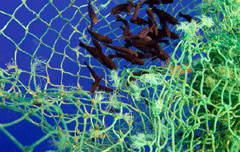
Pieces of lost fishing gear, like this “ghost” net, will trawl the ocean, collecting organisms, for years. (Photo: © Greenpeace/Alex Hofford)
GELLERMAN: So, Adam what can be done about all this plastic in the ocean? I mean somehow we’ve got to prevent it from getting in the ocean I guess.
WALTERS: Indeed. That’s the main thing that we have to do. To clean up the oceans would be an incredible task. The most important thing we have to do right now is to stop the flow of plastic into the sea. Now because the plastic is not coming from one point source all levels of society need to act if we are to have any effect on the amount of plastic that’s pouring out into the ocean.
GELLERMAN: Well, Adam have a good voyage.
WALTERS: Thank you very much, yes. I’m looking forward to us hitting the coast and it warming up a little bit.
GELLERMAN: Adam Walters is a consulting scientist with Greenpeace International Research Lab. We spoke to him from the Greenpeace Research Vessel Esperanza.
To see pictures and learn more about the “trash vortex” visit our website, www.loe.org.
Related link:
Greenpeace’s "Trash Vortex" website
LOE Mailbag
[LETTERS THEME MUSIC]
GELLERMAN: Time now to hear from you, our listeners.
We asked for feedback on a recent commentary and, boy, did we get it. We received a flood of phone calls and e-mails about Steve Curwood’s proposal that the federal government provide low interest long-term loans, like a mortgage, to make green power affordable to the average homeowner. Here’s Peter Hanigan of Albuquerque, New Mexico:
HANIGAN: I think it’s a great idea. It makes a lot of economic sense and it makes great environmental sense.
GELLERMAN: Peter listens to Living on Earth on KUNM and he wasn’t the only who liked the concept. Mary Irene Stevens tunes in to WBAA in West Lafayette, Indiana:
STEVENS: This is a very workable, clever plan. And we need to get onboard with this program.
GELLERMAN: Matthew Ochs from Chadds Ford, Pennsylvania said he jumped out of bed at 6:30 am to write us about this segment. He says, “there’s gold in them hills when it comes to green technology.” Matt writes a government-backed loan would be a great incentive. But it would come too late for him. He just installed a geothermal heating system in his house. It cost 40,000 dollars but he received just $300 in tax credit for it.
But not all our listeners were so enamored with federal green financing. One called in to say in a perfect world this would be great, but not in the post 9-11 economy. Many folks can barely pay their credit card bills and home mortgages, and would have a difficult time making these extra payments.
John Serafin of Palo Alto, California pointed out that loans to install solar panels would not help renters and notes that demand for solar panels currently far exceeds the supply. WKSU listener Edith Chase in Kent Ohio phoned to say that solar photovoltaics are too expensive and there’s another alternative.
CHASE: The cheapest kilowatt is the electricity you don’t use. Therefore, the most cost effective dollars would be to replace your air conditioner and furnace with energy star appliances. At the same time plant a deciduous shade tree on the southwest side of your home. Replace your windows and insulate the walls and attic in your home and smile in comfort this winter.
GELLERMAN: Peter Boyer listens to us on KALW in San Francisco. He suggests that before the installation of alternative energies “homes and business should be given a free energy audit to identify ways to offset the need for power in the first place.” Well, many utilities do just that so give them a call.
And while you’re at it, give us a call and a piece of your mind. Our number is 800-218-9988. Or write to 20 Holland Street, Somerville, Massachusetts, 02144. Our e-mail address is comments at loe dot org. And visit our web page at Living on Earth dot org. That's Living on Earth dot org.
Just ahead: Leading sheep to slaughter. Was it mad cow madness or the government taking sensible precautions? First, this Note on Emerging Science from Ian Gray.
Emerging Science Note/Nanorust
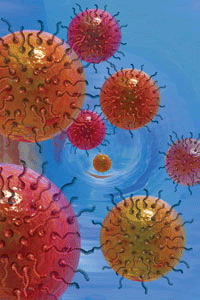
Nanoparticles of rust bind with arsenic in water. (Courtesy of Rice University Office of Media Relations and Information)
GRAY: Mmmm, a big glass of water, fresh, clean…exactly the kind of water that most people in the world don't have.
But, a team of scientists at Rice University is developing a low-tech filter that could help remove at least one unwanted contaminant from drinking water. The prime ingredients? — iron rust, magnets and olive oil.
The widespread contaminant is arsenic, a natural metal in rocks and sediments that can leech into ground water. Conventional ways of getting rid of arsenic are expensive, but the scientists from Rice say they’ve found a way to do it for cheap.

Nanoparticles of rust bind with arsenic in water. (Courtesy of Rice University Office of Media Relations and Information)
Since the nano particles are inexpensive to produce, the technology could be a boon for developing countries where arsenic is a big problem—countries like Bangladesh and Vietnam. The scientists hope they’ll be able to simplify the manufacturing process so that people in these countries can produce the nano-particles themselves. People could then use a low-tech filter and magnet to remove arsenic straight from their well water.
I’ll drink to that.
That this week’s note on Emerging Science, I’m Ian Gray.
Related links:
- "Nanorust Cleans Arsenic From Drinking Water"
- The United States Geological Survey’s fact sheet on "Arsenic in Ground-Water Resources of the United States"
- The World Health Organization on "Arsenic in Drinking Water"
GELLERMAN: Since you enjoy listening to Living on Earth, chances are you have some pretty good ideas about things that the program should cover. Good news, bad news or just plain interesting stuff. If you think it would make a worthwhile story for the radio, please get in touch. You can zap us an email at comments @ l-o-e dot org. Or call the Living on Earth listener line, at 800-218-9988. That’s 800-218-99-88. Or write 20 Holland Street, Somerville, Massachusetts 02144.
You’re listening to Living on Earth, on PRI, Public Radio International.
[MUSIC: Lewis & Clark “Dead and Gone” from ‘Solid PR Presents, Volume 1’ (Solid PR - 2005)]
Mad Sheep
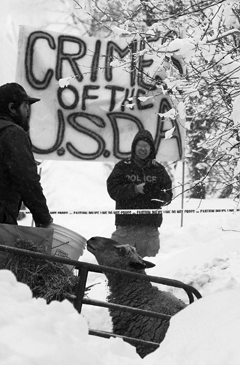
Jacques is taken by the USDA. (Courtesy of Chelsea Green Publishing)
GELLERMAN: It’s Living on Earth. I’m Bruce Gellerman. In 2001, fears that Mad Cow Disease had infected sheep on a family farm in Vermont, prompted federal authorities to take extreme action.
NEWSCAST: The government moved in at daybreak. Dozens of federal agents flanked by workers for the US. Department of Agriculture arrived at the Faillace farm in Warren to round up the 125 sheep. The owners meanwhile went about their chores in the barn, feeding the animals one last time.
GELLERMAN: Local TV station WCAX was on the scene in Vermont as Larry and Linda Faillace tried to stop the seizure and slaughter of their animals. After all, Mad Cow disease had never before been found in sheep.
NEWSCAST: The Faillace’s were surrounded by supporters as the animals were loaded, some stunned that the government did not want to hear an appeal to the case scheduled for April 10th. But the government says the risk to public health is too great and the animals must be destroyed. The demonstration was peaceful and there was no interference.
GELLERMAN: The Faillace family’s flock weren’t just any sheep. They were the first of their kind in America—rare breeds imported from Europe that produced unusually high quality meat and milk. Linda Faillace has written a book about her family’s experience called “Mad Sheep.” Living on Earth’s Steve Curwood recently spoke with Linda Faillace and her daughter Heather.
CURWOOD: Now you guys have been through quite an ordeal. It’s been six years now since you lost your flock. Why did you write the book?
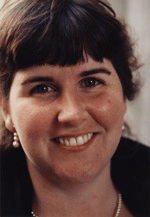
Author Linda Faillace (Photo: Dr. Larry Faillace)
CURWOOD: Now I know that there’s a related form of disease in sheep, it’s known as scrapies that’s not dangerous to humans. But mad cow disease in sheep? How would that be possible?
L. FAILLACE: Um, it’s not. Only under a laboratory have they been able to make sheep come down with mad cow disease. And so this was a theory that USDA came up with. And they said your sheep could have possibly been exposed to contaminated feed and be susceptible to mad cow disease. And if they had mad cow disease that would be traumatic and would you know possibly destroy the entire American sheep industry along with the cattle industry.
CURWOOD: Well, how did the government come to the conclusion that your sheep were sick?
L. FAILLACE: Without any evidence. Every single one of our sheep tested negative for any sort of disease, even the disease of scrapies which sheep can get.
CURWOOD: I’m now thoroughly confused. If your sheep tested negative for any form of this disease, how was it that the USDA was able to seize them?
L. FAILLACE: Right from the beginning it was very suspicious and very fishy because they said it was an atypical TSE of foreign origin. TSE is the umbrella term for diseases which include mad cow disease and scrapies and chronic wasting disease in elk and a few more. So by giving it this title it made it so the USDA did not have to follow their own protocols.

Jacques is taken by the USDA. (Courtesy of Chelsea Green Publishing)
L. FAILLACE: What they did was they kept testing all the animals and all the animals were testing negative. USDA put us under a formal quarantine, and after two years when we refused to give up the animals, they sent it to this outside lab, Richard Rubenstein’s lab on Statten Island. He comes up with the contrived positives.
CURWOOD: That’s a very strong charge, contrived test results. You’re alleging fraud on the part of this laboratory.
L. FAILLACE: Exactly. And then he claims in court when the judge – the federal district court judge – tells him to rerun the samples, he said oh, I inadvertently disposed of any remaining tissue samples. And he had enough samples from each animal that he could have the test a minimum of 25,000 times.
CURWOOD: These are very serious charges.
L.FAILLACE: And I’ll stand behind them.
CURWOOD: It’s clear from the book that the farm involved everyone in the family. And Heather, you’re now a junior at Middlebury College in Vermont. What were some of the tasks that you and your brother and sister were in charge of on the farm?
H. FAILLACE: Well, my tasks involved every morning from May to October twice a day getting up and milking the sheep. My sister made the cheese and my brother was pasture manager.
CURWOOD: Do you have a copy of your mom’s book there with you?
H. FAILLACE: Yes.
CURWOOD: On the front cover of your mom’s book, “Mad Sheep: the True Story Behind the USDA’s War on a Family Farm,” there’s a sheep sticking her face out of an animal carrier. Tell me about this sheep.
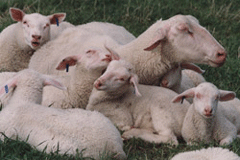
“All the lambs loved Martha, an East Friesian ewe.”(Photo: Amalia Elena Veralli)
CURWOOD: I’m so sorry.
H. FAILLACE: That’s Martha. She was one of my best milkers. We spent so much time with the animals every day that they became more like pets and family members. You grow up being taught that you should trust the government and then something like this happens and you just loose all faith. We lost our whole livelihood.
CURWOOD: Linda, your children were obviously so closely involved in this. How do you feel about that today?
L. FAILLACE: It’s really hard because it was a true family farm. Excuse me. Now I’m getting emotional. I don’t even know how to say it. It was something that I never ever expected to experience, I never ever expected my children to experience. I am extremely grateful for the opportunity to have had a farm. (pause breaks down) And I won’t, I won’t let USDA take that away.
CURWOOD: At the end of the day, why do you suppose all this happened?
L. FAILLACE: (takes a deep breath) I, I think the USDA’s trying to cover up the fact that they’re really really negligent at testing for mad cow’s disease in this country. I do not have faith in the food safety aspect of USDA. I have, I feel that food safety lies in the hands of the small farmers not in the hands of the USDA. USDA is too controlled again by the very agencies they’re supposed to regulate. And so I think that we were an example of USDA playing into the hands of politics and not abiding by science.
CURWOOD: You’re still on your farm. You’re still active in Vermont cheese making. What are your plans for the future?
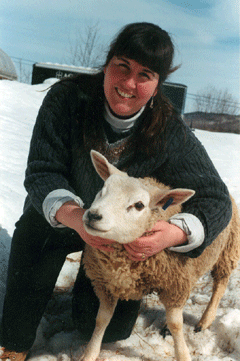
Linda Faillace and Moe. (Courtesy of Chelsea Green Publishing)
CURWOOD: How do you feel about your parents telling the story and maybe going back into farming themselves?
H. FAILLACE: I think it’s very important that our story gets out there. But as far as farming again, you know if they have the strength to, then I’ll be very supportive of that decision so…
L. FAILLACE: But you think we’re nuts?
H. FAILLACE: Yeah, but I think you’re crazy.
CURWOOD: Linda Faillace’s book is called, “Mad Sheep: the True Story Behind the USDA’s War on a Family Farm.” Thank you.
L. FAILLACE: Thank you Steve.
CURWOOD: And thank you, Heather.
H. FAILLACE: Thank you.
[MUSIC: Christmas Baubles “S” from ‘Christmas Baubles and Their Strange Sounds’ (Lo Recordings – 2002)]
GELLERMAN: Living on Earth asked both the USDA and the government’s former expert on mad cow disease, Dr. Linda Detweiller, to respond to Linda Faillace’s allegations. Both declined to comment, citing an ongoing lawsuit between the government and the Faillace family.
Related links:
- The Fallaice Family website Rootswork: Schoolhouse Market and Three Sheperds Cheeses
- "Mad Sheep: The True Story Behind the USDA’s War on a Family Farm"
- USDA Fact Sheet on sheep test results (2002)
- Official notice from the Federal Register of the USDA's State of Emergency to Seize the Sheep
High Art
GELLERMAN: Okay here’s a riddle: what’s eight feet high, 900 feet long, bright red, but green all over? Here’s a hint: it is green thinks nature even in the dark. Okay, I’ll repeat that. It is green thinks nature even in the dark. Give up?
Well, it’s called Indestructible Language. It’s a colossal new piece of conceptual artwork created by Mary Ellen Carroll. Ms. Carroll joins me on the line. Ms. Carroll, thank you very much.
CARROLL: Hi thank you.
GELLERMAN: Well, let’s help our listeners out with our riddle here. It’s 8 feet high 900 feet long and bright red but green all over. What is it?
CARROLL: My piece is a conceptual work of art. It takes the form of a neon sign comprised of 8-foot characters that roughly run about 900 linear feet on the American Cans building in New Jersey City, New Jersey
GELLERMAN: So what the red letters in neon spell out is “It is green thinks nature even in the dark.”
CARROLL: Yes, there’s a special typeface it makes it highly legible from up to four miles away. Something that you’re in an airplane flying into Newark or driving along Polaski Fifth Highway or on the Jersey Turnpike it’s going to be visible.
GELLERMAN: What’s the overall message there?
CARROLL: Well, the message is green. You know that we know global warming and global climate change exist. Green has a number of meanings and connotations. I mean we can talk about green colloquially, right, as money. And one of the big issues in terms of global climate change is the amount of money that’s being invested.
GELLERMAN: So, it is green refers to both money and environment. Thinks is about, well, thinking right?
CARROLL: What distinguishes human beings from other animals? I mean it’s the ability to engage in cognitive processes. And I think that given the amount of information it’s important to bring it back to the individual.
GELLERMAN: Nature obviously nature.
CARROLL: Well, nature we needed, you know there had to be another way of making it larger in the sense of being surrounded but then also to put it back to an exterior or something that was outside of ourselves.
GELLERMAN: And even in the dark.
CARROLL: It’s a question of having the information and how you choose to react or not to react. So do you choose to remain in the dark or do you choose to somehow affect the problem in some way?
GELLERMAN: Do you think people are actually going to get the message? Are they going to go, “huh?”
CARROLL: Oh, well, that’s a good question. You know one of the things that I keep hearing is the head scratching. It’s better to be scratching your head than I guess other parts.
GELLERMAN: Where did you get the idea for indestructible language?
CARROLL: Ahh It took a long time. Basically what I did was I created excel spreadsheets and came up with over 200 phrases. This was one of the top 5 in terms of being the most effective. You know, as an artist I’m not creating slogans or jargon. I mean that would be advertising. And it’s also not poetry. There’s a specificity to what it’s supposed to do and how it’s supposed to read.
GELLERMAN: I can just see a pilot coming in from some distant country flying into Newark airport for the first time and seeing, you know, “it is green thinks nature even in the dark” in bright neon letters on this old can company.
CARROLL: Uh huh.
GELLERMAN: And going, “what?!”
CARROLL: We can only hope that he makes an announcement over the PA system.
GELLERMAN: Marry Ellen Carroll is a member of the Precipice Alliance, a group of artists that’s using their artwork to draw attention to global warming. The collaborator’s first piece called “Indestructible Language” can be seen on the New Jersey Turnpike right near Newark airport and the Polaski Skyway.
Related links:
- Mary Ellen Carroll’s "Indestructible Language" Exhibition website
- "Indestructible Language" Exhibition Description
[MUSIC: Kaki King “Kewpie Station” from ‘Everybody Loves You’ (Velour Recordings, Inc. – 2003)]
Cranberries Take Centerstage
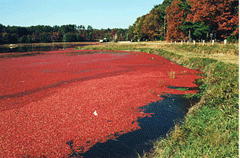
Cranberries are one of three native fruits of North America that are grown commercially. (Courtesy of U.S. Census Bureau)
GELLERMAN: The cranberry usually plays a humble role on American’s dinner table. But come Thanksgiving, it’s front and center stage, starring as sauce. The tart berry, one of just a few native to North America, got its start here in New England. Living on Earth’s Emily Taylor and Dennis Foley found that around this time of year, the cranberry is ripe for thought.
CAKOUNES: My name is Leo Cakounes and I run Cape Farm Supply and Cranberry company.
[MUSIC: Sue Keller “Cranberry Stomp” from ‘Ol’ Muddy: Riverboat Ragtime-Era Piano Sounds’ (HVR - 2003)]
CAKOUNES: Naturally what I think of when I hear the word cranberry is my mortgage payment because basically that’s what we do for a living is grow cranberries.
MAN: Thanksgiving time so cook them up for turkey.
WOMAN: Decoration with cranberries. I decorate at Christmas time with cranberries myself.
MAN: I suppose cranberry sauce. Having Thanksgiving dinner is definitely the theme.
CAKOUNES: There’s a lot of nostalgia with cranberries, associated with Thanksgiving and that’s understandable but for us it’s a crop that we grow for the purpose of making a living.
MAN: Well, I used to go wild cranberry picking on the Cape with my dad. He’d always take me up on the dunes and show me all the hotspots.

Cranberries are one of three native fruits of North American that are grown commercially. (Courtesy of U.S. Census Bureau)
GIRL: When I think of cranberries I think of coyotes because on Cape Cod there’s tons of cranberry bogs and around them thousands of coyotes live there.
MAN: Since I was a child. I think I was fascinated the first time I saw a cranberry bog.
MAN: The bogs and uh Cap Cod.
CAKOUNES: The harvesting process of cranberries is probably the most interesting process because that’s the time of year most people want to come and see a cranberry bog.
WOMAN: (singing) Did you ever go to the cranberry bogs? Some of the houses are hewed out of logs. The walls are boards that are sawed out of pine. That grow in this country called cranberry mine.
CAKOUNES: There’s two basic kinds of harvesting. There’s the dry harvest. The dry harvest is done first, usually mid September. It’s done when the bog has to be completely dry that means no dew or anything on it. The dry harvesting produces what’s called the fresh fruit. Which is the large cranberries that you buy in the store that the consumer ends up buying, the actual cranberry itself.
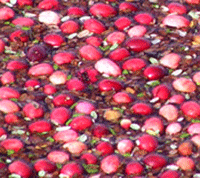
Cranberries were originally called “Craneberries” by the Pilgrims because their small, pink blossoms were a reminder of the head and bill of a Sandhill crane. (Courtesy of Massachusetts Department of Agricultural Resources)
WOMAN: He eats them plain, right out of the box. He and his sister both love to eat the cranberries plain.
MAN: I actually eat them plain a lot. I remember going to the museum and seeing them bounce down the little stairway for grating. We’d just pop them in our mouth.
WOMAN: I feel very puckered up and I feel like I’m going to eat something sour. I’m not interested at all…. (laughs)
MAN: The first time I had real cranberry sauce made with whole cranberries I was blown away it was marvelous stuff.
CAKOUNES: The second kind of harvest which is probably most familiar to people is called the wet harvest. And we drive a machine out on the bog which beats the berries off the vine and then coral them with either boards or a cranberry barrier. And that’s pretty much the picture that people see across the Cape and across cranberry country. And then those berries are pumped or loaded into an open truck with a conveyor and then they’re shipped to the supplier. And they’re actually called processed fruit. Those berries become your concentrate for drinks. They become your cranberry sauce.
MAN: For years I thought cranberry sauce was the stuff shaped like a can.
WOMAN: When I was a kid the only cranberries we ate were out of a can. But my mom would just put it on the plate whole in this gelatinous mass, you know. And she’d open up one end and it would just ooze out the other end and be like slurping sounds.
MAN: Canned cranberry sauce is almost never good.
WOMAN: The stuff in a can. You just sort of squish it out of the can and it sits there and giggles on the plate.
MAN: Slice it.
WOMAN: That’s right and you slice it, you can’t even serve it with a spoon.
CAKOUNES: The market for fresh fruit hasn’t really increased that much. There are still some people out there who are still dedicated to buy fresh cranberries and serve them on their Thanksgiving table and we think that’s wonderful. But we are really working hard producing new products. Hoping we can get into the candy market and the cereal market which will pretty much help us year round as opposed to waiting for one Thanksgiving dinner to pay our bills.
GELLERMAN: How sweet it is! Our cranberry audio postcard was produced by Emily Taylor and Dennis Foley.
Related links:
- Cape Cod Cranberry Growers’ Association
- Bog owner Leo Cakounes’ Cape Farm and Cranberry Company
- Cranberry Marketing Committee - USA
[MUSIC: Frances Perry ‘Cranberry Song’ from ‘The Library of Congress Archive of Folk Culture’ (Rounder Records – 2001)]
GELLERMAN: Next week on Living on Earth: attention shoppers! ‘Tis the season to hop into the car and head to the mall. A retail anthropologist is our guide.
UNDERHILL: I think retail is one of the dipsticks to the changes in our culture. That what makes a good store, what makes a good shopping mall is in a constant state of evolution.
GELLERMAN: The science of shopping next week on Living on Earth.
Living on Earth is produced by the World Media Foundation. Our crew includes Ashley Ahearn, Eileen Bolinsky, Tobin Hack, Ingrid Lobet, Emily Taylor and Jeff Young - with help from Bobby Bascomb, and Kelley Cronin. Our interns are Ian Gray and Jennifer Percy. Coverage of the Nairobi climate conference was funded in part by the Alliance of Communicators for Sustainable Development. Dennis Foley is our technical director. Our executive director is Steve Curwood. Alison Lirish Dean composed our themes. You can find us at loe dot org. I’m Bruce Gellerman. Thanks for listening.
ANNOUNCER: Funding for Living on Earth comes from the National Science Foundation, supporting coverage of emerging science; And Stonyfield farm organic yogurt and smoothies. Stonyfield pays its farmers not to use artificial growth hormones on their cows. Details at Stonyfield dot com.
Support also comes from you our listeners, the Ford Foundation, the Geraldine R. Dodge Foundation, and the Saunders Hotel Group of Boston's Lennox and Copley Square Hotels. Serving you and the environment while helping preserve the past and protect the future, 800-225-7676.
ANNOUNCER: PRI, Public Radio International.
Living on Earth wants to hear from you!
Living on Earth
62 Calef Highway, Suite 212
Lee, NH 03861
Telephone: 617-287-4121
E-mail: comments@loe.org
Newsletter [Click here]
Donate to Living on Earth!
Living on Earth is an independent media program and relies entirely on contributions from listeners and institutions supporting public service. Please donate now to preserve an independent environmental voice.
NewsletterLiving on Earth offers a weekly delivery of the show's rundown to your mailbox. Sign up for our newsletter today!
 Sailors For The Sea: Be the change you want to sea.
Sailors For The Sea: Be the change you want to sea.
 The Grantham Foundation for the Protection of the Environment: Committed to protecting and improving the health of the global environment.
The Grantham Foundation for the Protection of the Environment: Committed to protecting and improving the health of the global environment.
 Contribute to Living on Earth and receive, as our gift to you, an archival print of one of Mark Seth Lender's extraordinary wildlife photographs. Follow the link to see Mark's current collection of photographs.
Contribute to Living on Earth and receive, as our gift to you, an archival print of one of Mark Seth Lender's extraordinary wildlife photographs. Follow the link to see Mark's current collection of photographs.
 Buy a signed copy of Mark Seth Lender's book Smeagull the Seagull & support Living on Earth
Buy a signed copy of Mark Seth Lender's book Smeagull the Seagull & support Living on Earth

